john cage centenary: legacies and liberties
gail priest: the composers 2: john cage, bang on a can all-stars
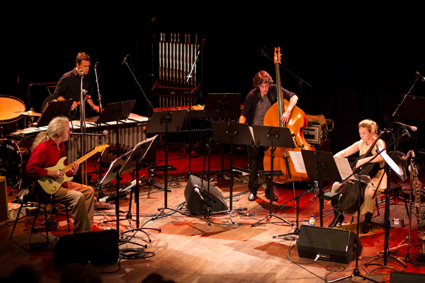
Bang on a Can All-Stars, The Composers 2: John Cage Centenary Celebrations, Sydney Opera House
photo Jamie Williams
Bang on a Can All-Stars, The Composers 2: John Cage Centenary Celebrations, Sydney Opera House
IT SEEMS TOO EASY TO START THIS ARTICLE WITH A QUOTATION FROM JOHN CAGE—A BON MOT THAT LIKE A GOOD HAIKU SAYS SEEMINGLY NOTHING AND EVERYTHING. AND WHICH PEARL OF WISDOM TO CHOOSE? HE WROTE SO PROLIFICALLY.
The paradox of Cage is that, arguably, his writing is better appreciated than his music—I’d suggest he’s more often quoted than played. This situation was to some degree perpetuated by the Sydney Opera House’s John Cage Centenary Celebration presented by Bang on a Can All-Stars from New York, which offered a small selection of Cage musical experiences complemented by a rich collection of his utterances and philosophising.
john cage and his american descendants
This was exemplified by the first concert of the two-day mini festival, titled John Cage and his American Descendants, which opened with two pieces by Cage performed simultaneously: Indeterminacy from 1959, a collection of Cage’s texts to be spoken in differing orders; and Variations II from 1961, for any number of players producing sounds by “any means,” guided by a graphic score of dots and lines that can be arranged in an almost infinite number of permutations. The master of ceremonies, guitarist (and one of the founding members of the band) Mark Stewart, tells us that the players each have “rigorously prepared” their part separately but not yet together.
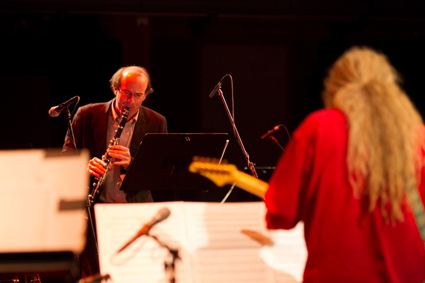
Bang on a Can All-Stars, The Composers 2: John Cage Centenary Celebrations, Sydney Opera House
photo Jamie Williams
Bang on a Can All-Stars, The Composers 2: John Cage Centenary Celebrations, Sydney Opera House
The next piece offers us even more of Cage’s wisdom, and better still, in his own voice. In An Open Cage, composer Florent Ghys took a recording of the man himself reading from the eighth part of Diary: How to improve the world (You will only make matters worse) and scored the ensemble parts according to the cadence of Cage’s voice. This technique can often result in abrupt and jagged, rhythmic figures, but Cage was a measured and lyrical speaker so the music develops a lilting edge within the uneven rhythms and phrases. This lyricism is ramped up and formalised by the middle of the piece where the text is subsumed completely and the piece finds its own jazzy rock style. It’s an interesting technique (one employed also to great effect by The Books) suggesting an embodied and material sense of the man and his words.
The remainder of the American Descendants concert consisted of works by three of the Bang on a Can All-Stars’ founding members (who were not present, the current touring party consisting of Stewart and musical guns for hire, and excellent marksmen at that). Sun Ray by David Lang delicately cycles unresolved phrases that shimmer like dappled light and gradually morph into an energising stabbing, syncopated conclusion. Michael Gordon’s For Madeleine, dedicated to his now deceased mother, juxtaposes a hovering piano line and long sweeping glissandi to create a quietly mournful incantation. Sometimes the insistent sliding notes feel like sirens, but increasingly ascend, leading to an ambiguous finale. It seems the filial relationship was a complicated one.
The concert concluded with Julia Wolfe’s Big, Beautiful, Dark and Scary, which true to its title starts at high energy and, like Gordon’s For Madeleine, it too revolves around ascending melodic phrases, this time creating a sense of both anxious and excited anticipation. It’s a piece that just gets gloriously bigger and bolder until it reaches a sustained cacophonous and utterly energising conclusion.
The pieces by the “American Descendants” are all rigorous and vigorous pieces of contemporary composition presenting challenges to even an experienced listener but also providing emotional touchstones, harmonic pleasure and metric rhythmic cohesion to satisfy a broader audience. How these pieces directly relate to Cagean techniques is not so clearly defined, except to say that everything after Cage has been undeniably affected by Cage’s philosophy, particularly his spirit of finding freedom within constraints.
ambient evolution
The second concert followed a similar format. First up was Sonatas and Interludes for prepared piano, a mid-career work written by Cage between 1946 and 1948 (earning him a Guggenheim Fellowship). While it has a strict mathematical structure and the preparations for piano are quite complicated, it dwells in far more harmonic territory than his later pieces and is inspired by his studies in Indian philosophy. The excerpted (and unidentified) sonatas and interludes occupy a tranquil and mesmerising zone of melodic fragments, the piano notes transformed by the string preparations into the soft metallic clangs of gamelan or deep reedy bamboo sounds, or broken music box tinkles. The Asian influence is strong in the harmonic choices and rhythmic repetitions with pianist Vicki Chow playing with a very delicate and lyrical touch to create a spellbinding experience.
Again, the program did not indicate which composed Improvisation Robert Black on bass and David Cossin on percussion were performing, but it exemplified the Cagean characteristics of instrumental parts existing on their own trajectory, little conscious layering and a disregard for transitions—here we see Cage concentrating on time as a container for actions and timbre rules over rhythm and harmony.
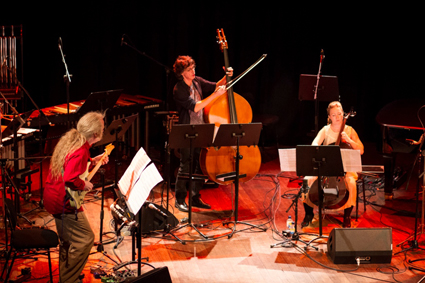
Bang on a Can All-Stars, The Composers 2: John Cage Centenary Celebrations, Sydney Opera House
photo Jamie Williams
Bang on a Can All-Stars, The Composers 2: John Cage Centenary Celebrations, Sydney Opera House
The connection between the Sonatas and Interludes and Brian Eno’s Music for Airports is evident. Eno is perhaps one of the few contemporary composers who can be compared to Cage in terms of the impact his Ambient music had on ideas of listening. Hearing the two works next to each other, their musical relationship is also clear, with both relying on a perceived simplicity, spaciousness and a kind of wandering cyclical structure. However Eno’s Music for Airports is like the extended mix—with each of his segments lasting 9-17 minutes—its very length creates the experience of floating and immersion. In his introduction to the piece Mark Stewart said that the music rewards both concentration and indifference and encouraged people to come and go from The Studio, however the audience remained in respectful concert mode for the almost 50-minute performance.
Each of the four movements of Eno’s work has been arranged by the founding members of Bang on a Can All-Stars: Michael Gordon, David Lang, Julia Wolfe and guest composer Evan Ziporyn. The live arrangements are faithful to the original, Eno’s pre-recorded instruments and electronic elements sensitively transposed to live piano, synthesiser, cello, bass, percussion, clarinet and guitar. What is necessarily different in the live interpretation is the sense of presence, not simply of the liveness of musicians, but the new instrumentation adds a three-dimensionality to the music which in original recording is deliberately planar. Seems it’s hard for these living, breathing musicians to emulate Eno’s intended flatness, their swells and crescendos (and by the end unabashed emotional inflections) resisting restraint and compression. This was in no way a bad thing, but rather an interesting testing of the threshold of ambience and expression.
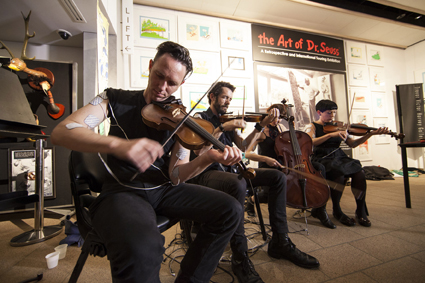
Michaela Davies’ Involuntary Quartet, Musicircus, The Composers 2: John Cage Centenary Celebrations, Sydney Opera House
photo Jamie Williams
Michaela Davies’ Involuntary Quartet, Musicircus, The Composers 2: John Cage Centenary Celebrations, Sydney Opera House
musicircus
By the time we exited from the airport ambience, Musicircus was in full swing—a cacophonous shock to our tranquil state. Cage’s Musicircus is a “happening” of simultaneous musical expression first performed in 1967. Any number of performers including dancers, actors and lay-people can present just about any piece relevant or irrelevant to Cage. This gathering was well wrangled by Sydney’s Ensemble Offspring and featured a hula hooper, toy piano players, tin whistle tooters, turntablists, a large furry animal and even a 18-month-old child, as well as Offspring and Bang on a Can All-Stars members, with each music station offering a pertinent printed quotation from Cage (of course!). The spread of acts along the long narrow foyer outside The Studio made it seem more an expo than a circus but there was no less sense of joy and play. And while some performers simply plied their trade others offered some serious experimentation such as Michaela Davies’ Involuntary Quartet in which electro-muscle stimulators literally shocked the musicians into playing; or the performance by clarinettist Nathan Cloud who used the movement of audience members across the foyer’s large square tiles as his score. Cage would definitely have enjoyed the romp.
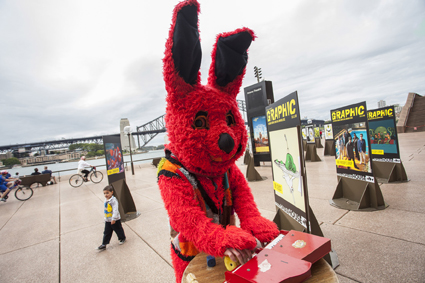
Musicircus, The Composers 2: John Cage Centenary Celebrations, Sydney Opera House
photo Jamie Williams
Musicircus, The Composers 2: John Cage Centenary Celebrations, Sydney Opera House
In fact the entire mini-festival had this tangible feeling of joy. While we only experienced a small sample of Cage’s actual musical output, we were well fed on his philosophy and spirit, which arguably is his lasting legacy. While I didn’t start with a quote, I’ll end with one from Brian Eno, as it encapsulates the idea of Cage’s oeuvre as being greater than the sum of its musical parts:
“In [Cage’s] case, composition was a way of living out a philosophy and calling it art” (program note).
This celebration reminded us that we have permission to do the same.
The Composers 2: John Cage, Bang on a Can Allstars, Ashley Bathgate, Robert Black, Vicky Chow, David Cossin, Mark Stewart, Ken Thomson; with Ensemble Offspring; The Studio, Sydney Opera House; November 2-3, 2012
See Keith Gallach’s review of the final concert, Permission Granted.
This article first appeared as part of RealTime’s online e-dition Jan 30, 2013
RealTime issue #113 Feb-March 2013 pg. 38






